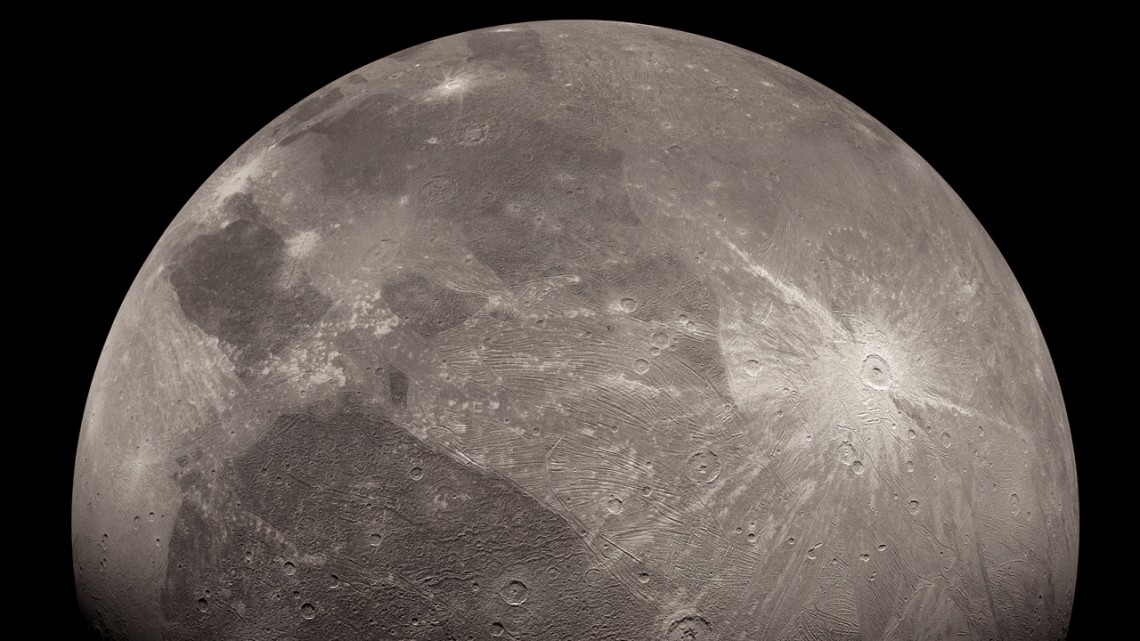
An enhanced image of the Jovian moon Ganymede, obtained by the JunoCam imager aboard NASA's Juno spacecraft.
James Webb Space Telescope sees Jupiter moons in a new light
With its sensitive infrared cameras and high-resolution spectrometer, the James Webb Space Telescope (JWST) is revealing new secrets of Jupiter’s Galilean satellites – in particular Ganymede, the largest moon, and Io, the most volcanically active.
In two separate publications, astronomers who are part of JWST’s Early Release Science program report the first detection of hydrogen peroxide on Ganymede and sulfurous fumes on Io, both the result of Jupiter’s domineering influence.
Samantha Trumbo, a 51 Pegasi b postdoctoral fellow in the Department of Astronomy in the College of Arts and Sciences, led the study of Ganymede, which published July 21 in Science Advances.
Using measurements captured by the near infrared spectrometer on JWST, the team detected the absorption of light by hydrogen peroxide around the north and south poles of the moon, a result of charged particles around Jupiter and Ganymede impacting the ice that blankets the moon.
“JWST revealing the presence of hydrogen peroxide at Ganymede’s poles shows for the first time that charged particles funneled along Ganymede’s magnetic field are preferentially altering the surface chemistry of its polar caps,” Trumbo said.
The astronomers said the peroxide is produced by charged particles hitting the frozen water ice around the poles and breaking the water molecules into fragments – a process called radiolysis – which then recombine to form hydrogen peroxide. They suspected that radiolysis would occur primarily around the poles on Ganymede because, unlike all other moons in our solar system, it has a magnetic field that directs charged particles toward the poles.
“Just like how Earth’s magnetic field directs charged particles from the sun to the highest latitudes, causing the aurora, Ganymede’s magnetic field does the same thing to charged particles from Jupiter’s magnetosphere,” she said. “Not only do these particles result in aurorae at Ganymede as well, but they also impact the icy surface.”
Trumbo and Michael Brown, professor of planetary astronomy at the California Institute of Technology, where Trumbo recently received her Ph.D., had earlier studied hydrogen peroxide on Europa, another of Jupiter’s four Galilean satellites. On Europa, however, the peroxide was detectable over much of the surface, perhaps in part because it has no magnetic field to protect the surface from the fast-moving particles zipping around Jupiter.
“This is likely a really important and widespread process,” Trumbo said. “These observations of Ganymede provide a key window to understand how such water radiolysis might drive chemistry on icy bodies throughout the outer solar system, including on neighboring Europa and Callisto (the fourth Galilean moon).”
The second paper accepted for publication in the journal JGR: Planets, reports new JWST observations of Io that show several ongoing eruptions, including a brightening at a volcanic complex called Loki Patera, and an exceptionally bright eruption at Kanehekili Fluctus. Because Io is the only volcanically active moon in the solar system – Jupiter’s gravitational push and pull heats it up – studies like this give planetary scientists a different perspective than can be obtained by studying volcanoes on Earth.
“This shows that we can do incredible science with the James Webb Space Telescope on solar system objects, even if the object is really very bright, like Jupiter, but also when you look at very faint things next to Jupiter,” said lead author Imke de Pater, professor emerita of astronomy and earth and planetary science at the University of California, Berkeley. De Pater and Thierry Fouchet from the Paris Observatory are co-principal investigators for the Early Release Science solar system observation team, one of 13 teams given early access to the telescope.
Media Contact
Get Cornell news delivered right to your inbox.
Subscribe
